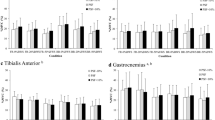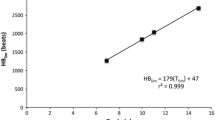Abstract
Oxygen consumption (\(\dot V\)O2), heart rate, ventilation and central rating of perceived exertion (RPE) in repetitive lifting while executing squat and stoop techniques were investigated in ten male forestry workers. In all five mass/frequency combinations studied,\(\dot V\)O2 was significantly higher for the squat than for the stoop technique. No differences were found in RPE between the techniques. The\(\dot V\)O2 and RPE recordings were also related to those obtained during maximal repetitive lifting (same lifting technique) and maximal treadmill running. The\(\dot V\)O2 expressed as a percentage of that obtained during maximal repetitive lifting with the same lifting technique was defined as relative aerobic intensity (%\(\dot V\)O2max, lifting). The %\(\dot V\)O2max, lifting was not significantly different between the techniques except for the lowest mass lifted (1 kg). This study therefore would support the hypothesis that RPE is more closely related to %\(\dot V\)O2max, lifting than to absolute aerobic intensity. Related to maximal treadmill running, it was demonstrated for both lifting techniques that relative RPE (percentage of the RPE during maximal running) was more accurate than relative\(\dot V\)O2 (percentage of maximal\(\dot V\)O2 during maximal running) for determining the %\(\dot V\)O2max, lifting in repetitive lifting. The study showed that the higher\(\dot V\)O2 during squat. lifting compared to stoop lifting was caused by the\(\dot V\)O2 expended in lifting and lowering the body rather than the\(\dot V\)O2 expended lifting and lowering the external mass. It was concluded that the stoop technique was not superior to the squat technique in terms of central RPE. Based on %\(\dot V\)O2max, lifting, there may be a rationale for choosing the stoop technique during repetitive lifting with light masses, but not with heavy masses.
Similar content being viewed by others
References
Astrand PO, Rodahl K (1988) Textbook of work physiology; physiological bases for exercise, 3rd edn. McGraw-Hill, New York, pp 501–512
Borg G (1970) Perceived exertion as an indicator of somatic stress. Scand J Rehabil Med 2-3:92–98
Ekholm J, Arborelius UP, Németh G (1982) The load on the lumbo-sacral joint and trunk muscle activity during lifting. Ergonomics 25:145–161
Fernandez JE, Marley RJ, Stubbs NB (1987) Lifting physical work capacity as a function of frequency. Proceedings of 31st Annual Meeting of the Human Factors Society. Human Factor Society, Santa Monica, Ca, pp 1331–1335
Garg A, Herrin GD (1979) Stoop or squat: a biomechanical and metabolic evaluation. AIIE Trans 11:293–302
Garg A, Saxena U (1979) Effects of lifting frequency and technique on physical fatigue with special reference to psychophysical methodology and metabolic rate. Am Ind Hyg Assoc J 40:894–903
Garg A, Chaffin DB, Herrin GD (1978) Prediction of metabolic rates for manual material handling jobs. Am Ind Hyg Assoc J 39:661–674
Hagen KB (1990) Biomechanical analysis of spinal load in motor-manual cutting. J For Eng 2:39–41
Hagen KB, Vik T, Myhr NE, Opsahl PA, Harms-Ringdahl K (1993a) Physical work load, perceived exertion and output of cut wood as related to age in motor-manual cutting. Ergonomics 36:479–488
Hagen KB, Hallén J, Harms-Ringdahl K (1993b) Physiological and subjective responses to maximal repetitive lifting employing stoop and squat technique. Eur J Appl Physiol 67:291–297
Hagen KB, Sørhagen O, Harms-Ringdahl K (1994) Influence of weight and frequency on thigh and lower-trunk motion during repetitive lifting employing stoop and squat techniques. Clin Biomech (in press)
Harstella P (1977) Ergonomic and technic aspects of bunching round timber in thinnings. Comm Inst For Fenn 89:3–37
Intaranont K, Ayoub MM, Bobo WM, Smith JL (1986) Physical lifting capacity: the anaerobic threshold approach. In: Karwowski W (ed) Trends in ergonomics/human factors III. Elsevier Science, North-Holland, pp 835–846
Kukkonen-Harjula K, Rauramaa R (1984) Oxygen consumption of lumberjacks in logging with a power-saw. Ergonomics 27:59–65
Kumar S (1984) The physiological cost of three different methods of lifting in sagittal and lateral planes. Ergonomics 27:425–433
Leskinen TPJ (1985) Comparision of static and dynamic biomechanical models. Ergonomics 28:285–291
Leskinen TPJ, Stålhammar HR, Kuorinka IAA (1983) A dynamic analysis of spinal compression with different lifting techniques. Ergonomics 26:595–604
Looze MP de, Toussaint HM, Nibbelke RJ, Eelderink HA (1992) Effects on efficiency in repetitive lifting of load and frequency combinations at a constant total power output. Eur J Appl Physiol 65:469–474
Looze MP de, Toussaint HM, Dieën JH van, Kemper HCG (1993) Joint moments and muscle activity in the lower extremities and lower back in lifting and lowering tasks. J Biomech 26: 1067–1076
Noble BJ, Metz KF, Pandolf KB, Bell CW, Cafarelli E, Sime WE (1973) Perceived exertion during walking and running II. Med Sci Sports 5:116–120
Pandolf KB, Noble B (1973) The effect of pedalling speed and resistance changes on perceived exertion for equivalent power outputs on the bicycle erogmeter. Med Sci Sports 5:132–136
Pandolf KB, Burse RL, Goldman RF (1975) Differentiated ratings of perceived exertion during physical conditioning of older individuals using leg-weight loading. Percept Mot Skills 40:563–574
Pandolf KB, Billings DS, Drolet LL, Pimental NA, Sawka MN (1984) Differentiated ratings of perceived exertion and various physiological responses during prolonged upper and lower body exercise. Eur J Appl Physiol 53:5–11
Sargeant AJ, Davies CTM (1973) Perceived exertion during rhythmic exercise involving different muscle masses. J Hum Ergol (Tokyo) 2:3–11
Toussaint HM, Baar CE van, Langen PP, Looze MP de, Dien JH van (1992) Coordination of the leg muscles in backlift and leglift. J Biochem 25:1279–1289
Trafimow JH, Schipplein OD, Novak GJ, Andersson GBJ (1993) The effect of quadriceps fatigue on the technique of lifting. Spine 18:364–367
Versteeg PGA, Kippersluis GJ (1989) Automated systems for measurement of oxygen uptake during exercise testing. Int J Sports Med 10:107–112
Welbergen E, Kemper HGC, Knibbe JJ, Toussaint HM, Clysen L (1991) Efficiency and effectiveness of stoop and squat lifting at different frequencies. Ergonomics 34:613–624
Zuxiang Z, Zhijun Z (1990) Maximum acceptable lifting workload by Chinese subjects. Ergonomics 33:875–884
Author information
Authors and Affiliations
Rights and permissions
About this article
Cite this article
Hagen, K.B., Harms-Ringdahl, K. & Hallén, J. Influence of lifting technique on perceptual and cardiovascular responses to submaximal repetitive lifting. Europ. J. Appl. Physiol. 68, 477–482 (1994). https://doi.org/10.1007/BF00599516
Accepted:
Issue Date:
DOI: https://doi.org/10.1007/BF00599516




